Mutter Museum in Philadelphia review: Gothic skulls & medical curiosities! Philly Goth travel guide.
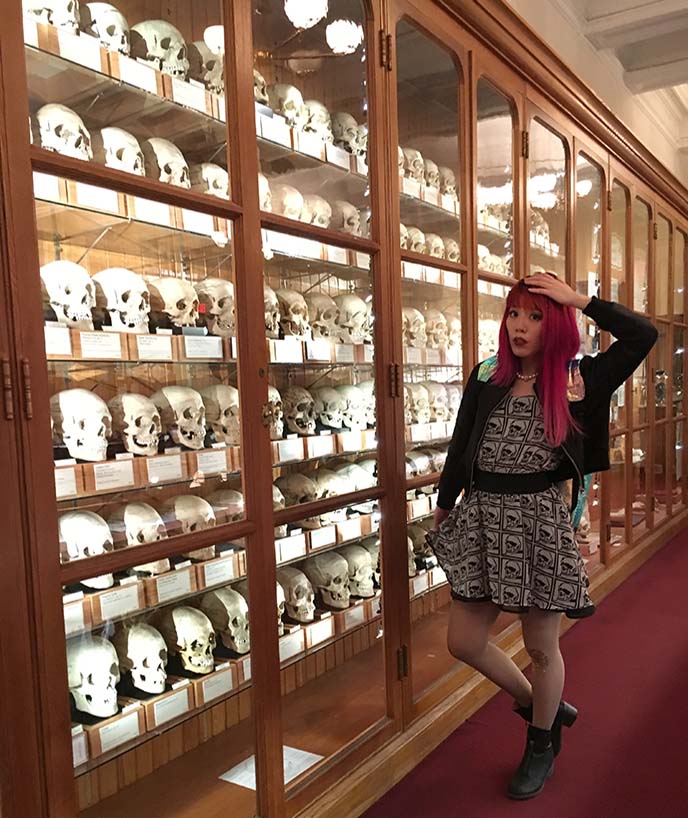
Welcome to Goth heaven… oh so many skulls! (I think I’m checking my head to make sure it’s still there.)
I recently ticked another Gothic destination off the bucket-list: Philadelphia’s Mütter Museum. This is one of the world’s most renown medical museums; a mesmerising collection of bodily oddities, pathological specimens, wax models, and unusual skeletons.
To get to Philly, I traveled from NYC by bus. It was an easy journey thanks to booking website Busbud, which lets you search for bus routes and compare prices/times/info in thousands of cities worldwide.

My bus ride was only two hours long, and took me to/from convenient downtown districts (meaning I could avoid long journeys to airports or train stations, and waiting times). Busbud turned out to be an affordable and sustainable way to travel like a local, which I’m all about.
Here I am in front of the Mutter Museum, psyched to see the “Disturbingly Informative” exhibitions. To match the occasion, I wore my skull-printed Gladnews dress, a Disturbia bomber jacket, and Gal Stern Luxury Tights with gold skulls over the knees. (Photography by Ashley Yuen and me.)
(Shop more styles from Disturbia below, with a click):
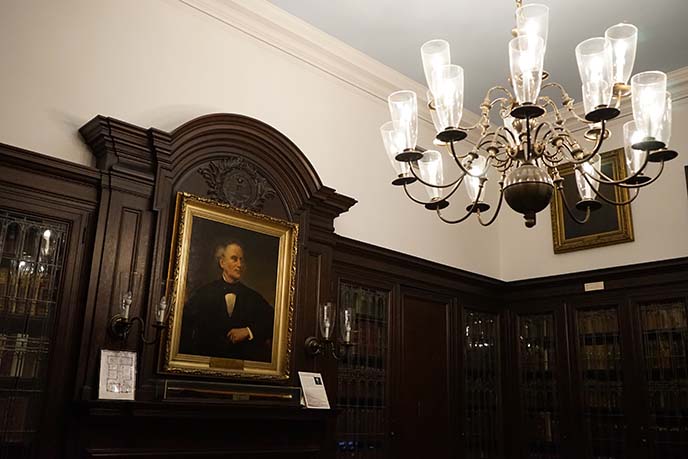
The museum is part of The College of Physicians of Philadelphia, a non-profit institution that promotes both the heritage and future of health and medicine. The College was founded in 1787, is one of the oldest professional medical organizations in America.
The man behind the name is Dr. Thomas Dent Mütter. He convinced the College to establish this educational museum, and donated the original collection in 1858.
Fun fact: Dr Mütter added the umlaut (ü) to his name after his travels in Europe! On a more serious note, he pioneered many important innovations in surgery. The doctor made significant advances in plastic surgery, insisted on cleanliness in a time before germ theory was recognised, and emphasized pre and post-patient care.

Dr. Mutter believed in the advancement of biomedical research, and wanted a place to share the 1700 medical samples he preserved over the years. Today, the Mütter Museum’s collection has grown to more than 25,000 items that help the public understand “the mysteries and beauty of the human body, and appreciate the history of diagnosis and treatment of disease.”
These curiosities include over 3000 osteological specimens, including these “skeletons in the cabinet” and a spinal segment of John Wilkes Booth (the murderer of President Abraham Lincoln).

Goths will adore the Hyrtl Skull Collection: there’s an entire wall that displays 139 human skulls! Joseph Hyrtl, a 19th century Austrian anatomist, put together this collection to show the diversity of cranial anatomy among various European groups.
Each of the bony rictuses seems to have a different personality. My personal favorite was the jolly-looking toothless skull of Geza Uirmeny, who “lived to 80 without melancholy.” He happens to be from Hungary or Romania, the country of Count Dracula.

Many of the skulls are inscribed with comments about the person’s age, place of origin and cause of death. The cards also convey this information (“Saxon, from Transylvania.”) Hyrtl built this collection to show the variations among Caucasians in Europe, in rebuttal to the claims of phrenologists (who believed race and intelligence/personality caused anatomical differences).

I adored the Mütter Museum’s classic setting, which resembles a 19th century “cabinet of curiosities.”
The specimens can be on the morbid side, such as depictions of skin diseases, and preserved fetuses with deformities in jars. However, I found these displays fascinating, as I love seeing the “beauty in the grotesque.” I’d say the Mutter is the perfect museum for travelers who gravitate to unusual, alternative attractions.
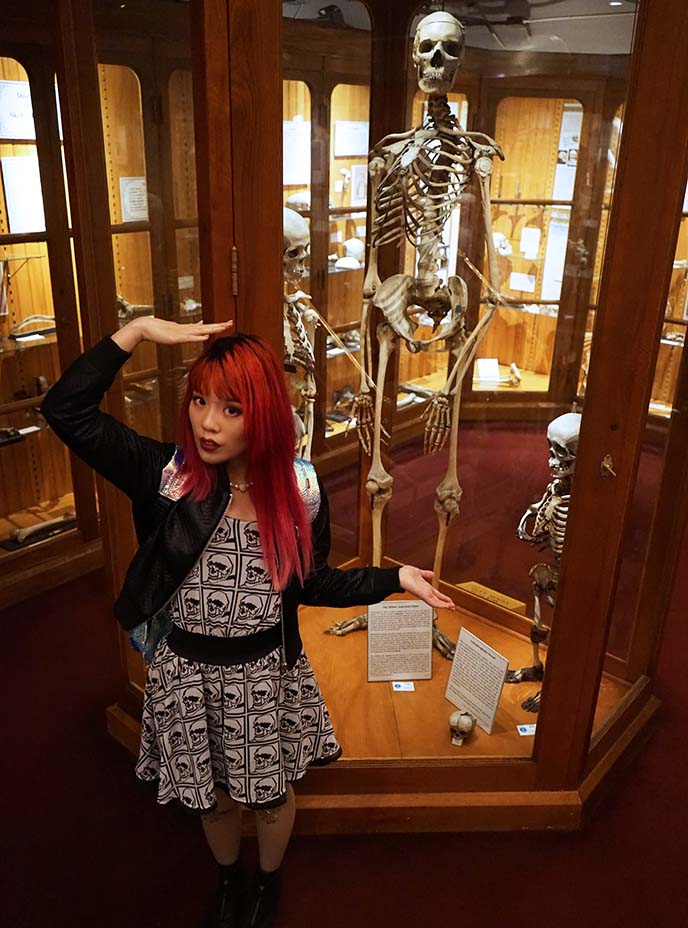
I can’t measure up to “The Mütter American Giant,” who looms over me at 7 feet 6 inches and is the tallest human skeleton on exhibit in North America.
Quite the size disparity between him and the 3 foot six dwarf skeleton on the right, which belonged to Mary Ashberry.

So interesting to see how various illnesses and trauma manifest on the human anatomy. From dental patterns to healed fractures, there’s a lot you can tell from a person’s bones.
Not everything is caused by genetics, injury or disease. Some of these “body modifications” are self-inflicted for various reasons, such as for the sake of beauty! On the right, you can see a regular ribcage compared to one that was narrowed by wearing a corset. The Mutter Museum also had preserved skin samples that show tattooing from the past.

One the museum highlights is a plaster cast of Chang and Eng, conjoined twins who were born in Thailand in 1811 (hence the term “Siamese Twins.”) They came to the US in 1829, and attracted large audiences as touring “freakshow” performers. The twins married sisters who later got into a fight — so the brothers spent three days at one wife’s home, then three days at the other’s!
Chang and Eng were joined at the sternum and had a fused liver, which is on display at the Mutter. Chang had a stroke and drank heavily, so his liver was large and deformed. He died after suffering a fall and bronchitis, and his brother followed three hours later.
Another famous resident of the Mutter is The Soap Lady, on the right. She’s encased in adipocere, an unusual fatty substance that formed because her burial environment was alkaline, warm, and airless.

The museum conveys medical information in different formats: photography, wax moulages, old illustrations, and even an interactive video re-enactment of a Civil War era amputation.

Many come to see the articulated skeleton of Harry Raymond Eastlack (left photo). He suffered from fibrodysplasia ossificans progressiva, a rare condition that affects the bone repair process, and slowly turns healthy muscle and tissues into bone. By his mid-20s, his vertebra had fused together, and he was locked in this position. When he died days before his 40th birthday, his body had completely ossified.

Behold… the Mega Colon. This gigantic tract belonged to a 29-year-old man who suffered from Hirschsprung’s Disease. The nerve supply to part of his large intestine was damaged, making it extremely difficult to pass waste (he would be constipated for a month or more). As his condition worsened, the abdomen and colon swelled enormously, sadly leading to his death. Upon autopsy, the colon was 8 feet long and contained 40 pounds of feces!

The exhibition visuals may be intense for some visitors, but I thought they were engrossing examples of pathology, intersected with history and culture. For example, above is a re-enactment of a prehistoric burial ground.
I’ve only shown you a small cross-section of the displays. You’ll have to come for yourself to see pieces of Albert Einstein’s unusual brain, a cephalothoracopagus (fetus skeleton with one head and two bodies), a jar filled with skin pickings (caused by mental illness), tribal shrunken heads, and a lady with what seemed to be a unicorn horn protruding from her forehead! (It’s actually a keratinous skin tumor that takes on the appearance of a horn.)

Philly’s College of Physicians is also home to the impressive Historical Medical Library. The shelves hold comprehensive journals from past centuries, and more than 400 incunables (books printed before the year 1500).
It’s also possible to rent out the stately halls and rooms, for special events. I pretended to be a doctor, giving a powerful speech at this Gothic-looking podium.
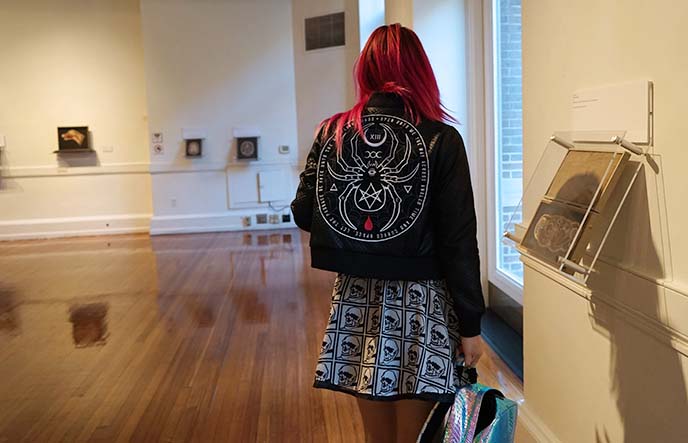
The Mütter also has spaces for rotating exhibits relating to the theme of the museum. I enjoyed Lisa Nilsson’s “Connective Tissue” — contemporary works that use ornate quilled paper to create anatomical cross-sections.
In addition, you can come to the museum for special events including talks, film screenings (like “The Cabinet of Dr. Caligari”), and an upcoming Halloween jazz speakeasy ball.
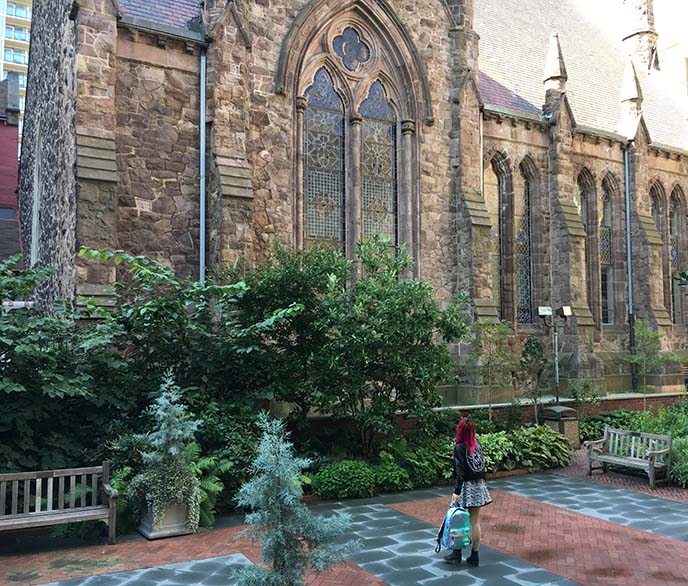
In my first travel diary about Philly, I took you to the Magic Gardens. I discovered yet another magical green space, at the Mutter Museum. (Photography by Ashley Yuen.)

This is the Benjamin Rush Medicinal Plant Garden, named after the Philadelphia colonial doctor and signer of the Declaration of Independence.
Rush helped found The College of Physicians in 1787, and wanted to establish a medicinal garden for natural healing ingredients.
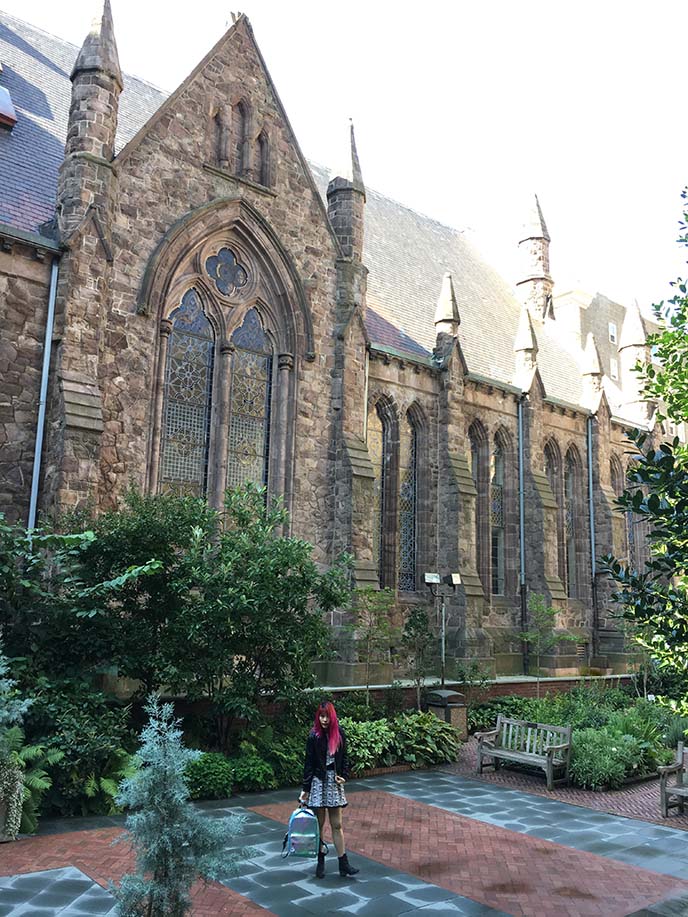
His dream didn’t come to realization until 1937, when the Mutter celebrated its 150th anniversary. Today, the Rush Garden has more than sixty different kinds of medicinal herbs, which give off a fresh scent as you walk through.
(The courtyard adjoins the First Unitarian Church of Philadelphia, pictured behind me.)

Don’t leave without a trip to the gift shop — it’s fantastic for those with a slightly morbid sense of humor! I picked up these two umlaut “mügs”, and squeezed a cute plush version of the megacolon. (You can also order items from the Mutter Museum online store.)
Above is a close-up of my Morbid Debutante necklace by Alex Streeter Jewelry. The white shell pearls and skull are the definition of Gothic elegance.

A deep bow to the Mütter Museum for inviting us to visit, and letting us take these exclusive photos! (Photography is not allowed inside the museum under regular circumstances, so this was a real treat.)
If you are visiting Philadelphia, this is a one-of-a-kind medical museum that can’t be missed. Check out the latest information on the Mütter website including admission fees, tickets, opening hours, special events and more.

I’ll end with some bonus Gothic coverage from my Busbud trip. First, a shout-out to the food scene in Philadelphia — everything I ate here was terrific! For those with a sweet tooth, I recommend Franklin Ice Cream (I had the black raspberry), and The Bakeshop in Rittenhouse Square (the ricotta scone with rainbow sprinkles is addictive).
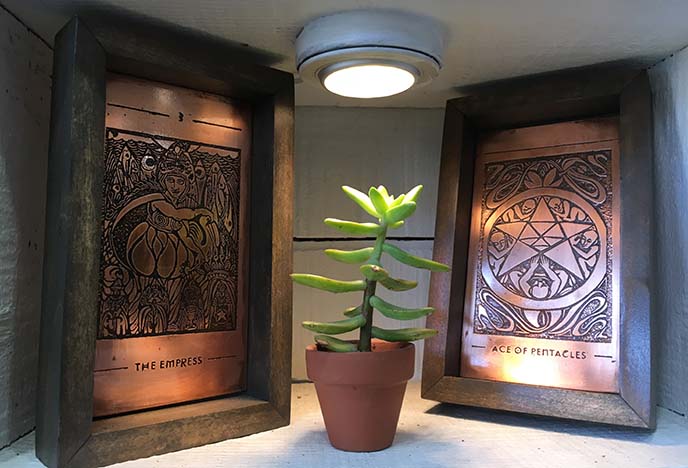
If you’re looking for Goth and alternative shops in the city, there are quite a few choices. I loved browsing at Ritual Ritual; a boutique filled with occult / nature wonders like tarot card art and plants.
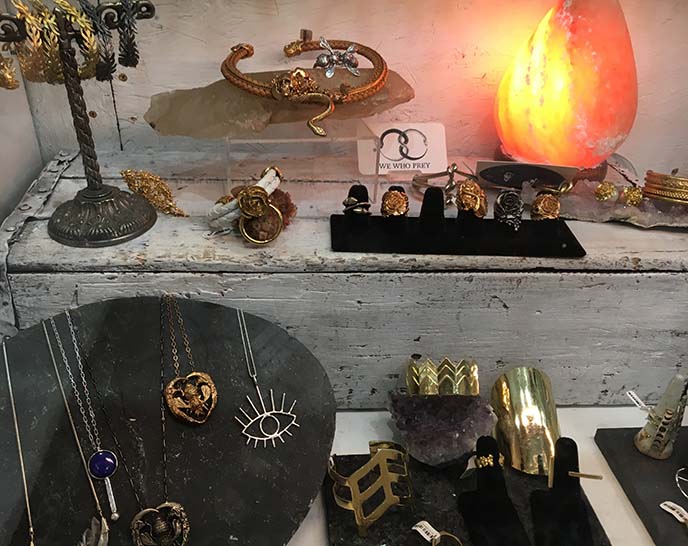
Ritual Ritual has a magnificent selection of artisan, local, handmade jewelry. They carry accessories by 60 independent designers from all over the county.

Many of the designs have dark, edgy themes that caught my attention. I see the devil…

… and skull-shaped planters and flasks.

“Rebels & mystics” describes this Philly boutique well.

These stories wouldn’t have been possible without Busbud, an innovative website that makes booking bus tickets a breeze. I could see all my routes and options for Philly-NY within seconds — saving me the time and stress of going through multiple bus sites.
Did you know of these alternative attractions in Philadelphia, Pennsylvania? PS, if you missed my first story, check it out: it’s about Philly’s Magic Gardens.
SHARE & COMMENT


 LA CARMINA
LA CARMINA







20 Comments
woo what a fun trip! nicely done research on the museum, it’s cool revisiting what we saw :)
Such a great time with you
I love this Museum!!
Skulls upon skulls upon skulls.
You should check out the antique store near by.
Ah must return soon
I would to go there. They did a special on it on the history ch. It was awesome. Would love go
I hope you can.
This is an awesome place.! My wife took me there for my birthday.
Fabulous!
Love this place! And, its history.
Yeah I wanted to go for ages!
Love
From
Germany
Cute girl
Happy Halloween.
Happy Halloween
Marveloso review of the museum
Thank you for writing about this collection. It appears you had fun!
I want to visit. Is it small inside?
It is quite large and there’s a Ton to see!
We’d love to have you visit the Wagner! We’re a preserved, Victorian natural history museum with lots of old taxidermy, skeletons, fossils, rocks, etc. in a display that dates back to the 1890’s. Send us a Facebook, Twitter, or Insta message if you want to stop by! http://wagnerfreeinstitute.org/